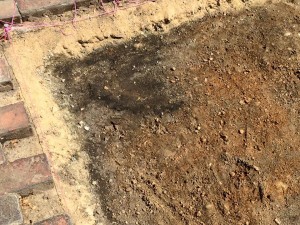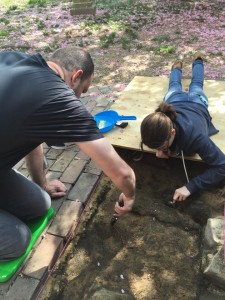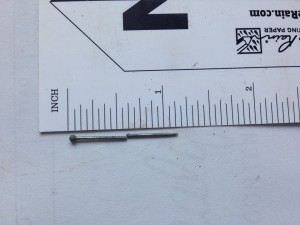Like most archaeologists, we spent our last few days in the field at Old Swedes creating a new archaeological record for the future as we backfilled the units we’d excavated. Finally, Ana, Kelsey and I relaid the brick paving that had sealed the archaeological remains we uncovered around the Church perimeter over the past six months. We placed 2015 pennies in the deepest spots of each excavation unit as another aid to future excavators of the time of our passing through this soil. We also gained greater appreciation for the stone masons and bricklayers responsible for building the church and laying the yards and yards of brick paving as we struggled to relay the bricks in the four different patterns that our predecessors had used, tightly, evenly, and smoothly. Let’s just say we’re better archaeologists than bricklayers!
Southwest Buttress Excavation showing graveshaft outlines
The last excavation whose story we’d left unfinished is the one just south of the church’s southwest buttress wall, outside the south porch. We’d chosen this spot because the GPR suggested that there were not any graveshafts here, although our excavations confirmed the presence of at least two, probably three, neatly aligned east-west. Each was marked by a 6-12”, irregularly shaped, unmarked stone that we found resting on the surface of the backfilled graveshaft, buried about one foot below the brick paving. Once we determined that they were graveshafts, we stopped excavation so we did not encounter any human remains or otherwise disturb the burial.
Now it’s back to the lab to finish processing and analyzing the artifacts and field data to help Holy Trinity Church and Old Swedes Foundation best plan to preserve this gem of an ancient church and the sanctity of its historic burial ground. We’ll keep you posted!
Lu Ann De Cunzo

















 we had to create our own shade to photograph so we pulled out our trusty UD blue hero capes (they are really just the tarps we use to cover the units) for the job. Feeling like heroes for the day was fun and brought a smile to our faces, which is our aim. Hero capes or no hero capes we still worked extremely hard to make some progress.
we had to create our own shade to photograph so we pulled out our trusty UD blue hero capes (they are really just the tarps we use to cover the units) for the job. Feeling like heroes for the day was fun and brought a smile to our faces, which is our aim. Hero capes or no hero capes we still worked extremely hard to make some progress.